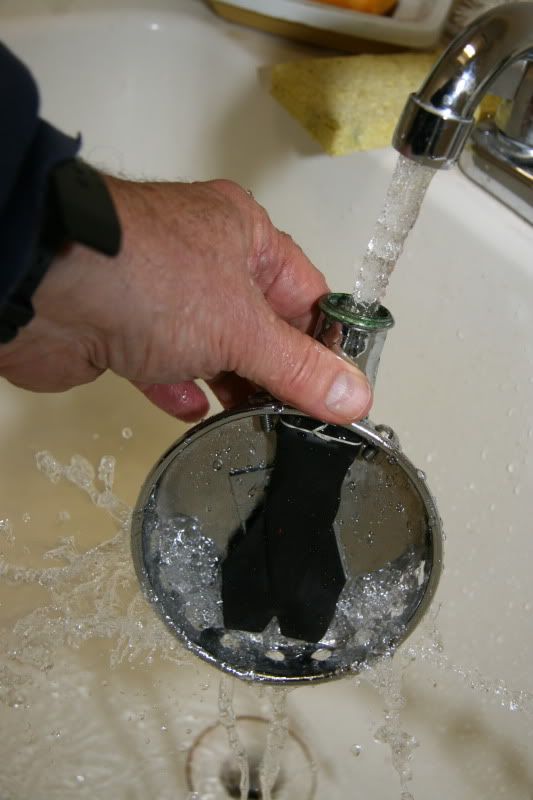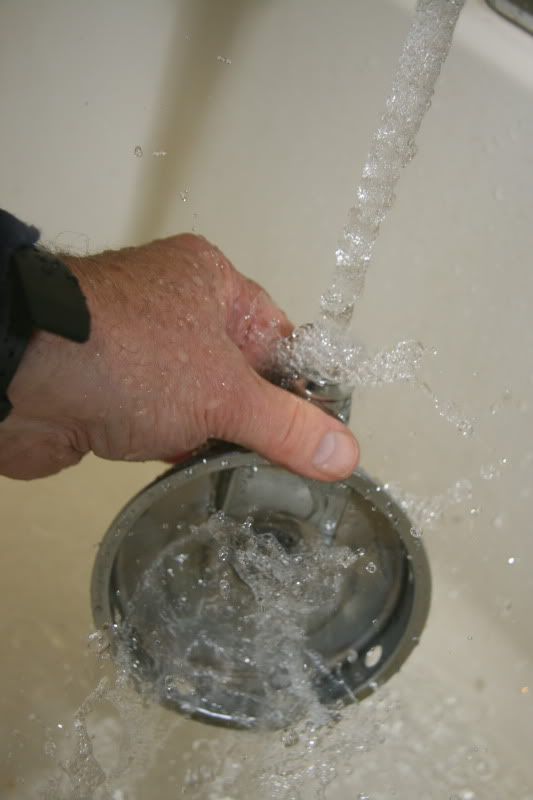Luis,
First, the name...my apologies We have a very dear friend named Lewis, and my fingers probably went to that as I typed. I am usually pretty sensitive to names, so I feel pretty badly about that.
Concerning science, without presenting any numbers I don't see how it could be interpreted as a "science project." That was not its intent. Your criticisms are right if, but only if, I was trying to say something from the demonstration other than the obvious differences that could be visually seen.
The science comes from the NEDU's different graphs of breathing resistance; I did not do that science, but it is publicly available.
Concerning the height and the amount of water flowed, I got those results not by "trying" to manipulate anything, but simply by putting the different cans under approximately the same flow. Nothing measured...this was a demonstration, not science, but whenever we try to describe something like resistance of show flow graphs, many find that hard to understand.
I have done some science in my time, but in the field of industrial hygiene. My MSPH degree is in Industrial Hygiene, and my Capstone Project was on occupational noise exposures. I have made
presentations concerning noise, which requires a lot of information on noise. So I am pretty familiar with the scientific method. Noise instruments need calibration, for instance, and you need to have a "chain of custody" for any sampling for chemical hazards in order to have varied results.
But I am also a diver, who is interested in vintage diving equipment. I do not own a flow bench, and so sought a means of demonstrating the differences is flow that these photos show. These were "tests" in that I tested the various equipment that I own to see how they perform. They were not "studies" and so do not even approach the criterion for publishable results. But they do demonstrate how water flows through the system. Was this science? No! Was it meant to be science? No! Was it a demonstration people could see and understand--maybe.
Let me give several examples of demonstrations.
--In teaching about double hose regulators, we can show clearing the mouthpiece by raising it above (higher than) the regulator to initiate free flow. Do we measure the number of inches above center line to initiate free flow? No! But it is an effective demonstration.
--In my work, I had workers who routinely worked with liquid chemical hazards--sulfuric acid, hydrochloric acid, hydrofluoric acid, and others like ammonia. These workers, when I first arrived, wore chemical protective clothing, a face shield and safety glasses. I had tried unsuccessfully to get them to wear chemical-protective goggles. They would not do it, as the goggles fogged. So I set up a demonstration where I wore safety glasses and a face shield, and had one worker splash me with a cup of water over the face shield. I got water into my eyes. It was effective in saying that their then-current practices needed to be upgraded. Splash goggles would not do it, so we went to powered air purifying respirators with chemical protective hoods (PAPR). It paid off when one worker was sprayed with 49% HF onto his PAPR-protected face. Was it a scientific demonstration? No! Did we quantify the amount of water splashed on my face? No! Did we match the viscosity of the water with the viscosity of sulfuric acid or phosphoric acid (79%)? No! Did we demonstrate that our then-current PPE was inadequate? Yes!
--I worked a lot with occupational noise. I also taught about hearing protection, and how to fit foam ear plugs. I showed how to roll them to get a good fit, how to place them into the ear canal, and the amount of protection they provided using a Noise Reduction Rating, along with an OSHA-required derating system for real world conditions. Was that science? No! Did we present numbers? Sort of--the NRR is a number, but may or may not be valid depending upon the fit of the plug. A year later, we had a 3M come out with a fit-testing machine for ear plugs, which actually took individuals, had them place the plug into their ear canal, and then measured the noise inside verses outside the ear. Was this science? Yes, it was applied science. Did it improve the fit of our hearing protection devices? Yes, dramatically.
So there is a place for science, but ScubaBoard is not a science venue. It is a discussion board, and the two should not be mistaken.
Luis (I got it right this time), if you have actual science to provide to this discussion, I would like to see it. If you have measurements of duckbills verses a mushroom valve, please present it. If not, please accept that there is a difference in trying to educate with a demonstration verses trying to apply science and engineering to the problem (this is sometimes hard for engineers--I have worked with many). In taking those photos, I was holding the camera in one hand and the bottom box in the other. It was never meant to be a scientifically-valid study, but rather a demonstration of what I had found.
You have helped me to see some of the problems with this demonstration, and I have asked my son about this too. He has his Masters Degree in Mechanical Engineering, and his thesis was on fluid dynamics. He explained some of the meaning behind the Reynolds Number and said that the main problem with my demonstration was that the velocities would be much different. He also mentioned that a duckbill would have virtually no resistance to flow, whereas the mushroom valve would have some as the valve would need to be lifted in order for flow to occur. But with the Duckbill Eliminator, I have looked at it and it appears that there would be very little resistance, as there is no direction change in the air flow. That was not the case for the Healthways mushroom valve I tested.
These kinds of discussions results in learning, and I have learned from this. My hope is that you can learn the difference between an educational demonstration and an engineering scientific study. This was not a "marketing" gimmick, as I am not a sales person, and have nothing to sell here.
SeaRat
---------- Post added February 24th, 2013 at 01:50 PM ----------
I have had several inverted duckbills, both the silicone type and a NOS duckbill. I use cage valves. I do not recall anything special happening, perhaps the hose got tugged a little, beats me.
Changing subject a little, the four double hose regulators that I dive frequently all have the DBVE, three have the HPR and two have the Phoenix conversion. I have band clamps on all of them. I love my Mistral with the DBEV, Superflex diaphragm, all silicone parts and band clamp. Breaths very nicely and requires virtually no maintenance, just a rinse out.
N
Nemrod,
I have been thinking about the inverted duckbill, and I think that with a thin duckbill, it would be possible with hose flexing to provide enough negative pressure to invert the duckbill. I like longer hoses, but many hoses are just barely long enough to reach the mouthpiece (depending upon regulator placement). If during an inhalation the diver turned his/her head to the right, and stretched the left exhalation hose, I think enough negative pressure could be imposed in the hose by the increased length to cause the inversion. However, I personally have not experienced such a duckbill inversion.
SeaRat







